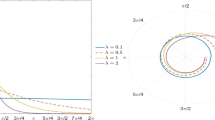Abstract
There is very little literature concerning modeling the correlation between paired angular observations. We propose a bivariate model with von Mises marginal distributions. An algorithm for generating bivariate angles from this von Mises distribution is given. Maximum likelihood estimation is then addressed. We also develop a likelihood ratio test for independence in paired circular data. Application of the procedures to paired wind directions is illustrated. Employing simulation, using the proposed model, we compare the power of the likelihood ratio test with six existing tests of independence.
Similar content being viewed by others
References
Downs, T. D. (1974). Rotational angular correlation,Biorhythms, and Human Reproduction (eds. M. Ferin, F. Halberg and L. van der Wiele), 97–104, Wiley, New York.
Fisher, N. I. (1995).Statistical Analysis of Circular Data, Cambridge University Press, Cambridge.
Fisher, N. I. and Lee, A. J. (1982). Nonparametric measures of angular-angular correlation,Biometrika,69, 315–321.
Fisher, N. I. and Lee, A. J. (1983). A correlation coefficient for circular data,Biometrika,70, 327–332.
Fisher, N. I. and Lee, A. J. (1986). Correlation coefficients for random variables on a unit sphere or hypersphere,Biometrika,73, 159–164.
Horimoto, K., Suyama, M., Toh, H., Mori, K. and Otsuka, J. (1998). A method for comparing circular genomes from gene locations: Application to mitochondrial genomes,Bioinformatics,14, 789–802.
Horimoto, K., Fukuchi, S. and Mori, K. (2001). Comprehensive comparison between locations of orthologous genes on archaeal and bacterial genomes,Bioinformatics,17, 791–802.
Johnson, R. A. and Shieh, G. S. (2002). On tests of independence for spherical data-invariance and centering.Statistics and Probability Letters,57, 327–335.
Johnson, R. A. and Wehrly, T. (1977). Measures and models for angular correlation and angular-linear correlations,Journal of the Royal Statistical Society, Series B, Statistical Methodology,39, 222–229.
Jupp, P. J. and Mardia, K. V. (1980). A general correlation coefficient for directional data and related regression problems,Biometrika,67, 163–173.
Jupp, P. J. and Mardia, K. V. (1989). A unified view of the theory of directional statistics,International Statistical Review,57, 1975–1988.
MacKenzie, J. K. (1957). The estimation of an orientation relationship,Acta Crystallographica,10, 61–62.
Mardia, K. V. (1975a). Statistics of directional data,Journal of the Royal Statistical Society, Series B, Statistical Methodology,37, 349–393
Mardia, K. V. (1975b). Characterizations of directional distributions,Statistical Distributions in Scientific Work, 3 (eds. G. P. Patil, S. Kotz and J. K. Ord), 365–385, Reidel, Dordrecht.
Mardia, K. V. and Jupp, P. J. (2000).Directional Statistics, John Wiley and Sons, New York.
Press, W. H. (1999).Numerical Recipes in Fortran, 2nd ed., Cambridge University Press, New York.
Rivest, L.-P. (1988). A distribution for dependent unit vectors,Communications in Statistics. Theory and Methods,17, 461–483.
Saw, J. C. (1983). Dependent unit vectors.Biometrika,70, 665–671.
Self, S. G. and Liang, K.-Y. (1987). Asymptotic properties of maximum likelihood, estimators and likelihood ratio tests under nonstandard conditions,Journal American Statistical Association,82, 605–610.
Shieh, G. S., Johnson, R. A. and Frees, E. W. (1994). Testing independence of bivariate circular data and weighted degenerate U-statistics,Statistica Sinica,4, 729–747.
Shimizu, K. and Iida, K. (2002). Pearson type VII distribution on spheres,Communications in Statistics,31, 513–526.
Singh, H., Hnizdo, V. and Demchuk, E. (2002). Probablistic model for two dependent circular variables.Biometrika,89, 719–723.
Stephens, M. A. (1979). Vector correlation.Biometrika,66, 41–48.
Wehrly, T. and Johnson, R. A. (1980). Bivariate models for dependence of angular observations and a related Markov process,Biometrika,67, 255–256.
Zhou, J. L., Tits, A. L. and Lawrence, C. T. (1997). A fortran code for solving constrained nonlinear (minimax) optimization problems, generating iterates, satisfying all inequality and linear constrains, Technical Report, No. TR-92-107r2, Electrical Engineering Department and Institute for Systems Research, University of Maryland.
Author information
Authors and Affiliations
About this article
Cite this article
Shieh, G.S., Johnson, R.A. Inferences based on a bivariate distribution with von Mises marginals. Ann Inst Stat Math 57, 789–802 (2005). https://doi.org/10.1007/BF02915439
Received:
Revised:
Issue Date:
DOI: https://doi.org/10.1007/BF02915439




